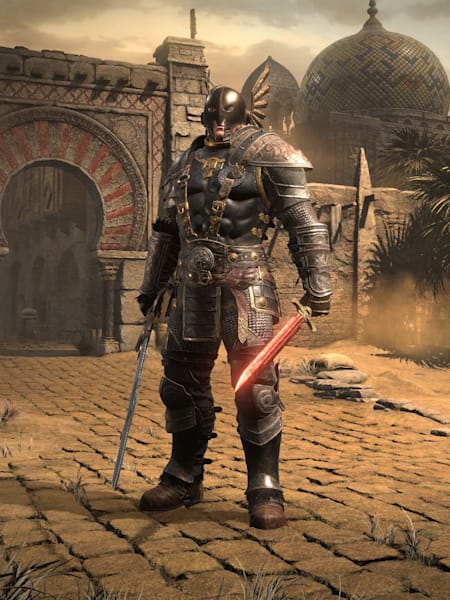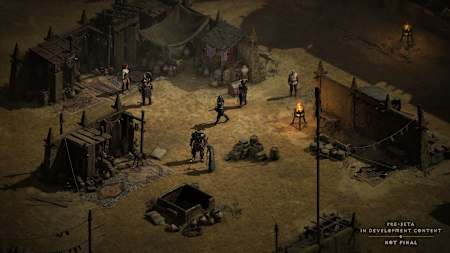Gaming
A Sequel that Defined a Genre
Compared to movies, the videogame sequel is often a very different thing. In films, where “bigger and louder” often leads to diminishing box office returns, game-design can improve and shine with that extra bit of scale in a game’s sequel. Looking at the earliest titles from Blizzard this can be seen with the transition from the first Warcraft to the second. That first game established the foundation of what a real-time strategy could be, and from there the team was able to let loose and ramp up the storytelling, tone, characters and atmosphere.
Released in 2000, Diablo II arrived with a similar sense of sequel-scale. Gone was the single dungeon found below the surface of the gothic town of Tristram; in its place a world full of ancient ruins, countrysides overrun by monsters, sand-swept dunes, far-away cities, giant palaces, and even Hell itself. A foundation that was built upon… and how.
And with new heroes ready to team up thanks to the dawn of the multiplayer-age, Diablo II supported 8-player co-op, and the first game’s action-RPG mechanics were refined and polished with an almost mathematical precision.
From a high-end GeForce RTX-powered rig to a Nintendo Switch, Blizzard is bringing Diablo II to an audience far larger than the one that played it back in the day...
Diablo II’s impact was two-fold: it presented another epic experience from Blizzard that helped establish the studio as a force to be reckoned with. A game chock-full of cinematic ambition and easy to pick-up-and-play gameplay. And, it also became the game the genre would look to for decades to come. From the New Zealand-developed Path of Exile to Blizzard’s own Diablo III to Torchlight, Destiny, Borderlands and many more. When people make the Diablo comparison, it all goes back to 2000’s Diablo II. It’s the action-RPG template, and the first major stop on the long loot-filled road of RPGs we’ve seen over the years.
Diablo II: Resurrected not only brings this iconic release back, but does so with impressively remastered visuals, several improvements brought to the fore, and support for modern PC hardware and consoles. From a high-end GeForce RTX-powered rig to a Nintendo Switch, Blizzard is bringing Diablo II to an audience far larger than the one that played it back in the day. And thanks to the recent Technical Alpha Test, we can safely say that it plays as great today as it did during the Y2K era.
Even with a controller in hand.
Preserving the Old Whilst Looking Brand-New
The original Diablo II featured a 2D presentation full of sprites and pixel-heavy animation. With everything on-screen presented at the now old-timey square-TV aspect ratio of 4:3 -- and at 25 frames-per-second. One look at Diablo II: Resurrection, however, and you wouldn’t be mistaken for thinking that this is a full-blown remake, built-from-the-ground-up ala Capcom’s Resident Evil 2.
With physically-based rendering, impressive lighting, detailed character models and a world that features crisp 4K 60 frames-per-second action, it’s essentially an artist’s rendition of what Diablo II would look like if it were made today.
“The inspiration is the original game,” Chris Amaral, lead artist on Diablo II: Resurrected tells us deadpanly. “Looking at all the original sprite art, and the reference images -- we had a whole archive of original files that we were able to pull from the original game.”
Looking at Diablo II today, that is the original version of the game, the images we see are 2D sprites created from detailed 3D models and then animated in a way reminiscent to how Rare brought Donkey Kong Country to the Super Nintendo. Fewer colours, approximated detail and compressed. And it's there, alongside concepts and detailed reference material, where the team working on Diablo II: Resurrected was able to recreate every piece of new art in 3D without making it look and feel like an entirely different game.
Filling in some detail here and there, but staying true to the look and feel. It's the best of both worlds.
“We also wanted to try to understand that original intention,” explains Rod Ferguson, executive producer on the Resurrected joint. “Fortunately we have people working at Blizzard today who were part of the team that made Diablo II. So being able to see the original 3D assets that were created, because the sprites were created from 3D models, has been fascinating.”
“With all the inventory art, we actually found documentation from the artists who made all of the original icon art,” Amaral adds. “Everything in there had a real-world reference, so we could find the exact real-world examples used. A lot of [Diablo II’s] look comes from historical imagery and real-world reference points, so we wanted to make sure that everything feels similarly time-period appropriate and functional.”
And it’s here where the Gothic almost medieval tone of Diablo takes root, and how the realistic visual style paved the way for an RPG that not only played unlike anything else, but looked like it too. In Resurrected you can see the shoulder straps and belts and how each piece not only fits, but is secured on a Barbarian or Amazon, for example. The same goes for the environments, which now pack incidental detail and little touches that add to that sense of realism.
“From our perspective we're just trying to add extra layers of details and elements, along with improvements to sound by adding more ambient effects, to add to the experience,” Amaral says. “When you enter that cave, you have the echoing, you have the dripping water, you have the new visuals.”
A Diablo II for Everyone
With its modern 3D visuals, Diablo II: Resurrected is a somewhat unique take on the whole ‘remastering an older game’ concept. Remake quality visuals, but only as a layer that sits on top of the original game. The Year-2000 core is not only here, where with a press of a button you can go back and forth between the two, but it drives all of the action.
We don't want to make the game easier...
Diablo II is one of those classic games where if even a single thing is changed, no matter how small or insignificant it might seem, it would send ripples through the community. A community that still exists to this day, with Battle.net servers still up and running housing players from all over the world, decades after the game’s original debut. This meant things like increasing Inventory sizes or removing the Stamina bar were immediately off the table.
“We don't want to make the game easier,” Rob Gallerani, principal designer on Diablo II: Resurrected asserts. “[And] then there's things where if we're going to do it, we need to make sure we do it at the quality you expect.”
One of these is being able to toggle on or off auto-gold pick-up, so players no longer need to click on each pile of gold as they drop from monsters. The second is the ability to play with a controller -- a decision that would open the door to many more players, but also a system that had to play nice with the original mouse-only Diablo II.
“The original game was played out on a grid and there was collision, but that collision and the 2D art didn't always line up,” Gallerani continues. “So you would have a stone wall and a couple of stones that kind of crumbled down. Well, however they decided to make it when they made it 20 years ago, there's just a couple spots where there's no collision. Or, there was a collision and they didn't even put a wall there.”
With a point-and-click interface, pathfinding would have your character move around the environment without much of a fuss. Throw in a controller where you can run up to a wall or into a rock, and there’s issues. With Diablo II’s grid this means there’s a small buffer between things like walls and other edges, and with this the team has spent and continues to spend time refining the controller-in-hand experience.
With cross-progression support this is the first time Diablo II will be playable on consoles, so the team is taking the time to make it all feel right. So much so that you’ll be able to play with controllers on PC -- something we did during the Alpha Test, and found the controls to be intuitive in ways that made Diablo III such a console hit.
A Modular Spectacular
This is also a version of the iconic game that Blizzard will continue to support for some time, and something that will be opened up to the community in much the same way the original game was...
With its almost unheard of 8-player online co-op, not to mention support for mods and things like custom servers, Blizzard isn’t locking off anything that would have worked with the original -- nor is this a closed remaster restricted to one particular playstyle. That said, security is an important part of Resurrection’s release on the account of how, well, hackable the original Diablo II was (and is).
“For item duping and things like that, a large share of our efforts is going towards making play on Battle.net as secure as we can make it,” Gallerani says. “Item duping not only ruins the economy for players, but some of the ways people do that is [that] they crash servers. And that doesn't make for a fun experience for anyone.”
Finding that perfect middle-ground means players can hack or mod an offline or non-Battle.net character, but you can’t transfer from one side of the Diablo II experience to the other. So this is also a version of the iconic game that Blizzard will continue to support for some time, and something that will be opened up to the community in much the same way the original game was.
“We absolutely love the modding community, which has helped keep this game alive for 20 years,” Gallerani says enthusiastically. “We’re going to welcome new mods too, but it's going to be a little bit different. We've taken a lot of things and moved them out of the code and put them into data – which should make it easier to mod. We don't want mods that inject code and hack the game, because that starts compromising the security too.”
And with the recent Technical Alpha Test, Blizzard has not only been pouring through the feedback, but looking at the almost universal praise its remaster efforts have received as proof of concept. It plays like Diablo II, but looks like Diablo 2(021).
“It was great to see people zooming in just to get a closer look at the extra detail; the knick knacks in the corners of the rooms; the additional storytelling elements; the environment art, and seeing them get more immersed in the world,” Amaral concludes. “It was exciting, and we're looking at everything, reading all the feedback.”
Diablo II: Resurrected is out 23rd September 2021 for PC, Xbox One, PlayStation 4, and Nintendo Switch.








